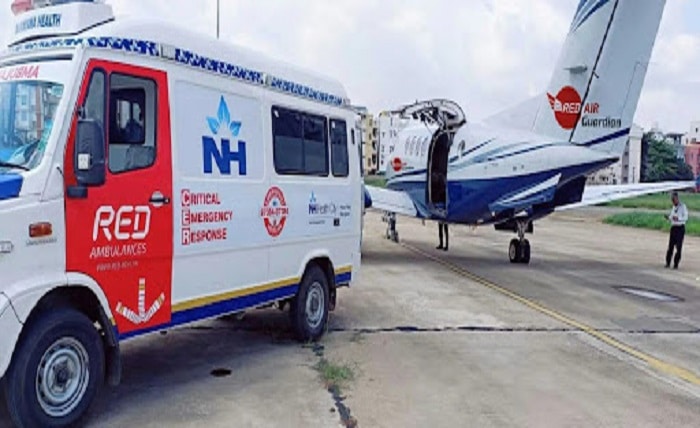What Influences Air Ambulance Charges? An In-Depth Look

Air ambulance services are in handy when there is an emergency because they can quickly evacuate people who require emergency medical attention. However, several factors can cause a large variation in the cost of these services. Individuals can better prepare for future emergencies and manage costs by understanding the factors that influence air ambulance charges. This blog will examine the factors affecting air ambulance service prices, giving you a close-up look at how rates are set and practical advice on how to keep expenses under control.
1.Distance of Transport
The distance of the journey is one of the main variables affecting air ambulance charges. The cost increases with the distance traveled. There are various causes for this:
Fuel Costs: Longer flights use more gasoline, which raises the cost of operations.
Crew Time: Longer flight durations result in higher crew labor costs.
Maintenance and Wear: Extended flights put the aircraft through more wear and tear, which raises the expense of maintenance.
Distance is a significant component in the pricing structures of air ambulance services; therefore, knowing this information will help you estimate future expenses more precisely.
2.Type of Aircraft
The kind of aircraft utilized for air ambulance services can significantly influence costs. The cost of operating various aircraft types varies as well:
Helicopters: Because they require more frequent maintenance and fuel, helicopters are more expensive per hour, even if they are great for short-distance and emergency missions.
Fixed-Wing Aircraft: Typically utilized for lengthier flights, these can be more economical. Nevertheless, these aircraft can also be costly to maintain initially.
The patient’s medical requirements, availability, and distance all play a role in the aircraft selection process, which also affects the final cost.
3.Medical Equipment and Supplies
The kind and quantity of medical supplies and equipment needed for the travel may impact the costs. Ventilators, heart monitors, and other specialist medical equipment are expensive for critical care. Among the factors are:
Equipment Costs: Buying and maintaining specialized equipment is frequently high.
Supplies: Medical supplies, intravenous fluids, and other medications raise the expense of care.
The air ambulance service charges extra for more advanced medical services.
4.Medical Personnel
The number and quality of medical staff on board significantly contribute to the total expense. An air ambulance team usually consists of:
Flight Crew: Consists of pilots and co-pilots who are in charge of maintaining the aircraft safely.
Medical Team: Depending on the patient’s condition, this team may include paramedics, nurses, and doctors.
Although the presence of highly qualified and experienced medical professionals guarantees that the patient will receive the proper care, but their knowledge comes at a cost.
5.Insurance Coverage
Insurance coverage is crucial when calculating the out-of-pocket costs for air ambulance services. Various insurance plans, such as the following, may pay all or part of the expense:
Health Insurance: Certain health insurance plans provide coverage for air ambulance services; however, the terms and limitations of coverage differ.
Travel Insurance: Depending on the situation, travel insurance may pay for air ambulance costs for individuals visiting overseas.
Medical Evacuation Insurance: A specialized insurance that pays for emergency medical transportation expenses.
Knowing what your insurance covers and any restrictions might significantly impact the total amount you pay.
6.Destination
The air ambulance’s destination has an impact on charges as well. Destination-related factors include:
Accessibility: Locations that are more remote or difficult to reach could require extra planning or money.
Landing Fees: Depending on the region, airports and landing sites may impose fees for aircraft landings.
The total cost of the air ambulance service may increase due to the logistical challenges involved in getting to the destination.
7.Urgency of the Situation
The cost may vary depending on how urgent the crisis is, as emergency responses frequently include:
Immediate Deployment: Emergency scenarios may call for a quick response, which could lead to increased costs because of the requirement for prompt mobilization.
Priority Scheduling: If the service provider has to reschedule or assign more resources, high-priority instances may result in higher charges.
Because an urgent situation requires a quick and thorough response, it may command a higher price.
8.Operational Costs
An air ambulance service’s operational costs include a variety of expenses related to its operation, such as:
Aircraft Maintenance: Keeping an aircraft in good operating order and ensuring its safety and dependability require routine maintenance and servicing, which raises operating expenses.
Fuel Costs: Variations in the price of fuel can have an impact on total costs, particularly on longer flights.
Insurance and Licensing: The price of the aircraft’s insurance and the medical staff’s licenses also affect the charges.
Comprehending these overhead expenses might offer a valuable understanding of the total air ambulance charge service structure.
9.Regulatory Compliance
The following rules and regulations that air ambulance providers must abide by may have an impact on costs:
Safety rules: Following strict guidelines and keeping expensive equipment in working order are necessary to comply with safety rules.
Medical Standards: Complying with medical standards and obtaining staff and equipment certifications raises the overall cost.
Although it can raise the cost of air ambulance services, regulatory compliance guarantees high standards of safety and care.
10.Provider Contracts and Agreements
Costs may vary depending on the terms of the contracts that air ambulance services have with medical institutions or insurance providers. Among the factors are:
Provider Agreements: Certain providers may have negotiated prices or discounts in their contracts.
Healthcare Facility Charges: The cost of services may vary depending on some healthcare facilities’ agreements with air ambulance services.
Understanding these agreements helps facilitate cost negotiations and the search for less expensive services.
The Bottom Line
Various factors determine air ambulance charges, including distance, aircraft type, medical equipment, personnel, insurance coverage, destination, urgency, operational costs, regulatory compliance, and provider contracts. Individuals who understand these components can better prepare for the prospective costs of air ambulance services and manage expenses more effectively.
It is crucial for anyone looking for air ambulance services to take these things into account and speak with service providers to grasp the associated costs fully. Furthermore, examining coverage options and revising insurance policies can assist in reducing out-of-pocket expenses. Ultimately, a better understanding of the factors influencing air ambulance costs will help you make better decisions and be more emergency-ready.




